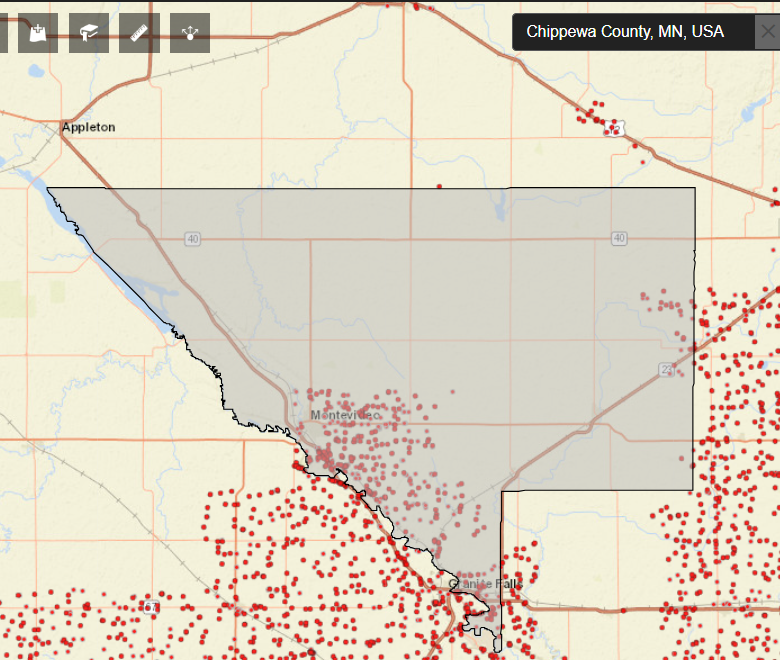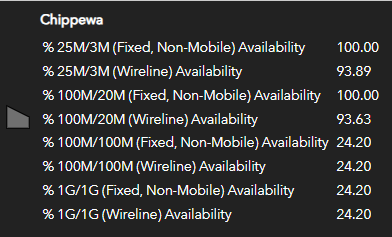Chippewa County
| Year | Rank | 100/20 Mbps |
|---|---|---|
| 2024 | #28 of 87 | 93.63% |
| 2023 | #44 of 87 | 84.52% |
| 2022 | #43 of 87 | 80.55% |
| 2021 | #37 of 87 | 82.67% |
| 2020 | #29 of 87 | 83.55% |
| 2019 | #31 of 87 | 81.7% |
| 2018 | #77 of 87 | 24.8% |
| 2017 | #69 of 87 | 24.45% |

Red dots represent unserved locations.

Wired (wireline) and wireless (fixed, non-mobile) served location percentage at various speeds.
Chippewa County a Nice Jump in the Last Year
Chippewa County’s rank bumps from 44 to 28. Percent coverage went from 84.52 percent to 93.63 percent. They have seen progress in the last two years, which is a momentum I hope they can continue.
While efforts are being made to improve broadband, Chippewa County retains their yellow ranking because they have a way to go.
Chippewa County is in a potentially precarious position because looking at access in Chippewa County using the FCC National Map there is a big discrepancy between wireline access and wireline with fixed wireless. Minnesota doesn’t currently take fixed wireless into consideration when defining areas eligible for grants; the federal government does include access to fixed wireless. That could make a big difference to who is eligible for BEAD funding.
- Over the years, Chippewa County (or cities within) has invested $ 2,889,447 (total) for matches for 1 successful MN Broadband grant. This is an indicator of local government that is engaged and (literally) invested in better, local broadband.
- Chippewa County will benefit from a $2,081,494 MN Broadband grant award to reach 283 locations between Chippewa and Renville Counties.
- Chippewa County will not benefit from any line extension awards.
- Last years’ estimates indicated that it would cost $6.8 million to get ubiquitous broadband in the county. (I haven’t updated the number because recent report offers scenarios of costs based on BEAD funding rules that make current estimates less predictable than in the past. Yet, I think the number is still helpful.)
- In 2022, Chippewa ranked 54 using Microsoft’s Digital Equity Tool, which looks at various factors of a community.
- Chippewa County is in a potentially precarious position because looking at access in Chippewa County using the FCC National Map there is a big discrepancy between wireline access (76.09 percent coverage) and wireline with fixed wireless (98.3 percent). Minnesota doesn’t currently take fixed wireless into consideration when defining areas eligible for grants; the federal government does include access to fixed wireless. That could make a big difference to who is eligible for BEAD funding.
Household Density
8.0
Number of Providers
17
As of 2023 · Source: MN DEED
Households with Device Access
statewide
statewide
statewide
statewide
statewide
Has Worked with Blandin Foundation
Yes
There is a matrix of Minnesota broadband adoption projects; it includes projects from this area.
Has Received MN Grant(s)
Yes
2015 – MVTV Wireless Middle Mile, Grant award: $808,080
2022 – Farmers Mutual Telephone Company, $4,728,186.00
2024:
- County: Chippewa, Renville
Hanson Communications
Hanson – Chippewa Cty W
Grant: $2,081,494
Local Match: $2,544,150
Total Budget: $4,625,644
Hanson will build and operate a Fiber To The Premises (FTTP) network covering the unserved and underserved areas within Southwest Chippewa County. There are 283 total fiber passings in the project. This project comes in partnership with Chippewa County, who has committed $200,000 to the project. Over 68 businesses lacking a 100/20 mbps connection are included in the project area. Most businesses in the project area are related to agrobusiness, machinery, construction, transportation, services & consumer goods. For livestock operations, broadband is a necessity. Remote monitoring and alarm systems, critical for ensuring the health and safety of livestock, rely heavily on broadband connectivity. Additionally, the process of buying and selling livestock and equipment at online auctions is emerging in the online marketplace.
Government Districts
U.S. Congress: CD 7
MN Senate: 15, 16
MN House: 15A, 16A